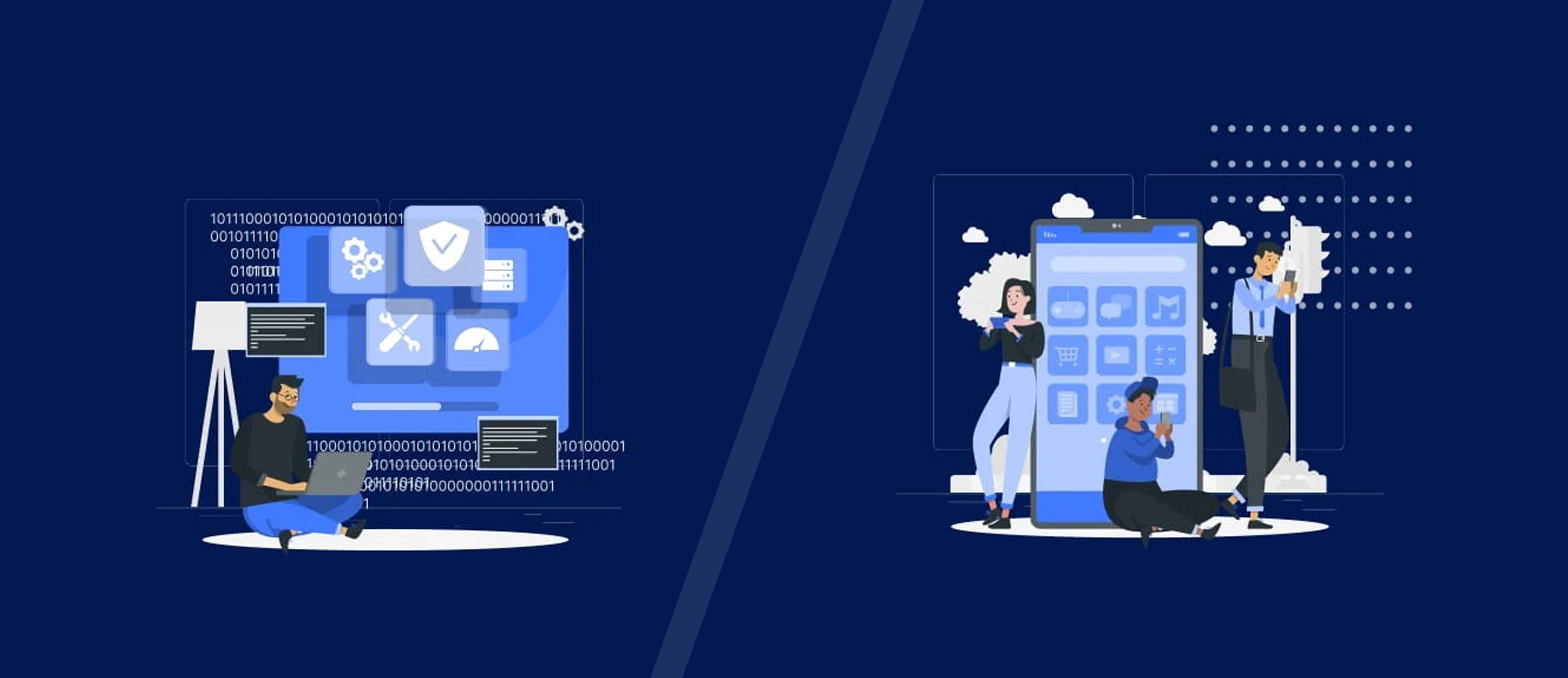Table of Contents
Daily life — work and play — now involves countless mobile applications. Whether it’s on a phone or a tablet, we rely on apps for the majority of our time spent online. In 2022, mobile users outnumbered web users and this year, Statista projects that worldwide mobile users will reach 7.33 billion.
How we use apps, the services and products available in applications, and how commercial, private, and government organizations bring apps to the App Store and Google Play is always changing. The app market isn’t immune to trends and in this blog article, we are reviewing 10 of the leading mobile app trends shaping application development in 2025.
10 mobile app development trends for 2025
- Natural Language Processing (NLP)
- Cross-Platform Development
- User Interface (UI) Design
- Augmented Reality (AR) & Virtual Reality (VR)
- Privacy Support Platforms
- Mobile Health (mHealth)
- E-commerce
- User Input During Beta Testing
- Cashless Payments & Payment Gateways Integrated
- Internet of Things (IoT)
Read on to learn how these 10 trends affect how target markets access applications, how this is a factor in which mobile app developers to hire, and what is next across the standout and subset areas of mobile applications.
Mobile App Development Trend 1. Natural Language Processing (NLP)
Natural Language Processing (NLP) is a major subset of Artificial Intelligence (AI) and central to many of the features of contemporary mobile app development that enable powerful, customized, and interactive user experiences (UX). As a market, NLP is currently worth over $12.43 billion USD according to a report from Emergen Research in December 2022. For both mobile app developers and the global mobile user market, November 2022 marked a historic moment in NLP as the OpenAI prototype ChatGPT became freely available via their website. Though ChatGPT is not an app at this point, the technical accuracy, reliability, sophistication, and scope of the platform is considered an indicator of what we can all expect from this branch of AI in 2025 and beyond: NLP functionalities that can complete live interactions, flag errors in code, compose original content, and assist with resolving a wide range of problems. For developers working on custom applications, this extends into voice search and AI-powered interactions with advancements improving the UX, customer experience (CX), and how data analysis and coding problems are resolved in the development and update processes. Now that ChatGPT has received a substantial multibillion-dollar investment from Microsoft and Google is reported to be reassessing how it approaches its own competitor product, LaMDA, this is a ‘watch-this-space’ trend for how it will affect mobile app development in the year ahead.
Mobile App Development Trend 2. Cross-Platform Development
Cross-platform development is a strategy to deliver high-value returns for customers wherever they are. In 2025, this means taking compatibility to the next level with custom application development that performs without the price tag. This new era of development invests in a custom product that bit more attractive thanks to the option to bring to market a product that’s capable of being deployed over various platforms despite having a single code base. The fact that the product is developed using a single programming language means that there is also a quicker turnaround for an app that is then immediately deployable in the App Store, Google Play, and for all other OS — there’s no stress waiting to go to market while the products for the other operating systems are being built. Cross-platform development is estimated by Market Research Future to acquire a value of $70.59 billion USD by the end of 2030 with a CAGR of over 26.46 percent for the 2022-2030 period; this is a logical estimate due to the return on investment with the deliverable of a consistent UI/UX across platforms. More seamless application development means easier customer support, streamlined maintenance, and a better brand experience no matter the platform.
Mobile App Development Trend 3. User Interface (UI) Design
The look and feel of the UI is an undeniably influential part of UX so we would be remiss to ignore the trajectory of this facet of mobile app development in 2025. With trend forecasting, we are observing a new wave of influential factors — in this case, it’s a “vibe shift” — in application design across all areas, and right now, this means that UI design is changing within technology, too. Experts are already flagging that the algorithmic influence of TikTok, Instagram, and LinkedIn are shaping trends on a macro app-wide level that’s well beyond the micro-user level of what the individual sees; the content prioritization of what users see in their app feeds or ‘For You’ page is no longer solely derived from their own taste, it’s also from what the algorithm selects for them and this is blurring what UI design means. The decisive response from UI designers is now that instead of a futuristic trend forecast of polished reality, the app interface is likely to emulate an entirely unknown visual narrative that bears a close resemblance to the speculated metaverse. In the UXDesigns ‘The State of UX in 2024’, Fabricio Teixeira and Caio Braga report that UI has a new feeling, “Instead of reminding us of the problems of our current world and the harm that’s been caused by Big Tech, the new, abstract forms of web3 distract us from the crises of the day with the promise of a new virtual world.” So, the UI of the months ahead is most likely going to be cyberspace-leaning in a movement away from an augmented version of our current reality and tilt more towards an entirely digitized, three-dimensional form. This shift in UI will be fresh and foreign compared to the two-dimensional sans-serif mimicry and replications of the last five years.
Mobile App Development Trend 4. Augmented Reality (AR) & Virtual Reality (VR)
In 2025, one mobile app development trend that will continue to get used in the same sentence as ‘revolutionize’ is Augmented Reality (AR) and Virtual Reality (VR). How everyone experiences the world around them and the digital world is changing as the lines between the various forms of AR/VR — and the metaverse — blur with the offline world. This year, immersive and expansive technology is only going to become more accessible as both work and play overlap with AR/VR. From professional training and meeting colleagues in the metaverse to shopping virtual boutiques and VR drone racing, every major tech, business, lifestyle, fashion, and entertainment company is leaning into the metaverse. Businesswire attests that, “Younger, digitally native generations are moving cultural expectations of the internet; increasing demand in the media, entertainment and gaming industry; augmented, virtual, and mixed reality (MR) technologies amplifying the metaverse capabilities are some of the key factors driving the growth of the current metaverse market.” The impact of how AR/VR incorporates apps and hardware as well as web portals in tandem with the developments yet to be seen in this market verge on this being the year that all speculation about extended and virtual reality is realized: apps like Pokemon Go that augment reality and apps that offer an entirely virtual experience like Google Earth VR are just the beginning.
Mobile App Development Trend 5. Privacy Support Platforms
User and organizational privacy as part of daily life are going nowhere this year and that’s because cybersecurity is a leading agenda item for anyone online. Whether it’s cloud security or individual digital footprints, everyone experiences vulnerability of some kind, both personally and professionally, when they are on the internet. Mobile app development that works to integrate cybersecurity and digital hygiene protocols in all online activity is a must. 2022 was characterized in many ways by the scale of high-profile cybersecurity breaches with high volumes of sensitive user data stolen then held for ransom and in 2023 the cost of cybercrime is predicted to hit $8 trillion USD says Cybersecurity Ventures. This trend has, without question, a colossal reach for victims and target victims alike. In 2025, it’s urgent that the trend of using cybersecurity, digital hygiene, and privacy apps goes mainstream as the scale of damage caused by identity theft, phishing, data breaches, physical intimidation and larceny, and financial threats is exponentially compounding. This year, the integration of even just Virtual Private Networks (VPN) and password manager apps into the online activity of users and organizations has the potential to thwart attacks if not just deter cybercriminals while upgrading account security and internet traffic measures.
Mobile App Development Trend 6. Mobile Health (mHealth)
The Mobile Health (mHealth) app market is having a sustained moment in the sun as we enter the fourth year of the pandemic. Holistic health is finally possible with the Telehealth, pharmaceutical and medicinal, nutritional, fitness, and wellbeing areas supported in the myriad of applications available in the App Store and Google Play. For developers, the challenge is to engineer applications that can encrypt and manage sensitive user data and enable secure appointments while for health providers and professionals, the challenge is to maintain results and meet patients where they are in a comprehensive delivery of clinical care. As a market, Digital Journal considers this one of “continued growth”, with the diversification scope for mHealth apps encompassing education, wearables, AI, data gathering and analysis, and clinical studies. In 2025, this niche of app development can continue in numerous directions as Digital Journal explains further, “These health mobile apps utilize intelligent data analytics and mobile technologies to offer the best care possible at a low cost from convenient locations.” Overall, developers are well-positioned to deliver applications engineered for the patient experience with this focused on in the UX/UI, security frameworks in coding, and extrapolation of user data that is then utilized in scaling services and delivering patient-centric product updates.
Mobile App Development Trend 7. E-commerce
E-commerce is another trend that overlaps with many other technology topics. Development progress means that increasingly developers can engineer e-commerce UI that are robust yet refined and offer a shopping experience that users prefer over web-based shopping portals with one 2022 survey from Newstore finding that 31 percent of respondents preferred e-commerce app shopping over in-store and mobile or desktop websites. As preferences have shifted to e-commerce app dominance, the UI and UX both need to be designed to keep users from exiting and switching to another shopping app: this is why trend features like AR allowing for virtual try-ons, personalized shopping driven through the algorithm and data analysis, live customer support through chatbots, and seamless shopping from social media product placement or advertisements with Instagram all nurture a profitable app. E-commerce is an app niche that is already using AI to tailor UX, support customers, and analyze data to configure the UI making it one of the most cutting-edge areas of technology where another trend like NLP is widely incorporated. There is also scope for an omni-channel strategy to win over customers though apps, as we’ve already touched on, are dominating the e-commerce space, and building an incredible application is a worthwhile, proven approach to converting app visitors into buying customers.
Mobile App Development Trend 8. User Input During Beta Testing
So much is invested in development, therefore seeking user input is part of delivering quality development. In an elevated development process, thoroughly testing applications with users is a non-negotiable phase ahead of deployment to market. Nevertheless, many businesses skimp on this vital step and it’s a costly mistake to make. Trend forecasters speculate that this tactic, though not easy, is trending as the crowded market is an exceptionally hard place to stand out in. The outlook of any app launch should be “user-driven innovation” as Max Kraynov espouses for Entrepreneur, “With beta testing, app developers and companies are becoming increasingly focused on growing communities as there is a growing realization that a more diverse range of voices is essential for feedback and product tweaking.” In addition to making beta testing a priority and gathering data about their prototype, both developers and their clients can surmise if there is any features they have missed or they may even find that there is a component of the UX that can be re-engineered to offer a unique selling point they didn’t know their target users are looking for. Allowing the target market time with the product, asking for their input, and gathering field user data is priceless because, regardless of how great an update might be, if someone has already downloaded and discarded an app, they are highly unlikely to give it a second go. Remember: in the app world, there is only one chance to wow and win users.
Mobile App Development Trend 9. Cashless Payments & Payment Gateways Integrated
This trend partially incorporates e-commerce however it is a standalone aspect of this forecast as mobile app payment gateways have expanded rapidly in recent years. Covid-19 has undoubtedly contributed to the omnipresent reliance on these payment gateways for almost anything we can name — travel, public transport, food ordering and grocery delivery services, healthcare — and how easy it is for users and businesses to have a smooth pathway for digital payments. These gateways also make for cashless in-person payments so traditional brick-and-mortar businesses aren’t hit with EFTPOS machine fees that can make their operations unbearably cost-prohibitive. Finally, the powerful e-commerce functionalities with mobile wallets integrated across most apps now give users extra security for purchasing without compromising UX. In the past, users have reported abandoning their online purchases — 1 in 5 shoppers have done so — when faced with a complicated, laborious checkout UI. This generation of payment gateways don’t sacrifice security for the UX or a slick UI; household names like PayPal and Stripe are seen as more trustworthy choices that have advanced credentials to verify and allow payments. It is worth noting that one shortcoming for developers and businesses is that some payment gateways aren’t available in certain regions and countries meaning that it is worth thoroughly assessing the target market of the app with developers prior to choosing the mobile payments gateway for integration.
Mobile App Development Trend 10. Internet of Things (IoT)
Our final trend, the Internet of Things (IoT), including the market of wearables, is arguably a physical world of things now as we see automobiles, smart devices, household devices, healthcare, and display devices almost everywhere. The ubiquity of the IoT is reflected in the numbers with Statista describing the “tens of billions of these IoT connected devices” in existence in 2021 while forecasting that the market value will be around $1.6 trillion USD by 2025. Use of these devices is nearly always via an app, for connecting and control or for data review and personal utility, thus meaning mobile app developers have a central role in the UX of these physical devices. How the user flow in the mobile app for IoT affects the device functionality itself is a grey area though it is safe to say that ensuring the features and functionalities of the product are clear in the UI is always paramount. Furthermore, as the use of IoT continues to grow, and even at this moment with smart home devices such as thermostats controlled via apps, there is a serious responsibility for developers. Although most app standards are managed as part of pre-launch risk audits, this is a significant example of how reliant most people are on mobile app development meaning that from here it could be hypothesized that this kind of development process will be even more rigorously managed and monitored closely for safety to mitigate any danger to the public.
Using These Trends In Mobile App Development Or To Hire Mobile App Developers
Trends show both the direction of a range of markets and equally can be used to inform the objectives that works best for a new development. Choosing the mobile app developer company to hire is going to be a detailed process and taking the time to discuss experts’ opinions, and experience, with these topics is worthwhile. Subsequently knowing when not to leverage a trend is as crucial as leveraging it well, therefore pursuing a deeper understanding of these trends and strategic discourse with a team of expert developers, designers, and engineers is going to have an invaluable return on investment when it comes to the development process and the final product that goes to market.






